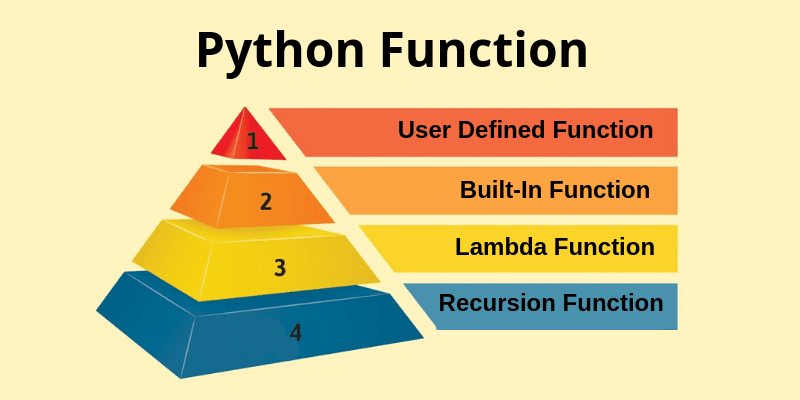In this tutorial, we will discuss what python functions are, how to write a function and how to use it? So let's discuss Python Function.
Python Function
What are the functions in python?
With the help of function, the reusability of code become popular. A function is defined as a collection of code used to perform a specific task. Functions are used as re-using of one code again and again. Functions are also known as modules. Every programming language has the concept of function and function works on a principle DRY (Don’t repeat yourself).
Types of Functions in python:
There are two types of functions in python
- Built-in functions
- User-defined function.
Built-in functions
All those functions already defined in python are known as python inbuilt functions. Some examples of inbuilt functions:
print()
input()
str()
User-defined functions:
All those functions that the user creates to perform a specific task are user-defined. To write a function we use a keyword def.
Syntax to write a user-defined function:
def function_name(parameters):
'''docstring'''
function_body or statement
Some points related to function:
-
To define a function, we use a keyword
defbefore every function name. - Every function should have a function_name which ends with the parentheses.
- Inside the parenthesis, we can pass the parameters which are optional.
- The docstring is a string inside the function between the triple single quotes, which is used to give the information about the function.
- Inside the function, you can use the return statement, which is optional.
- To call a function, we write the function name with the parenthesis.
Let’s all the concepts of Python function with an example.
User-defined function with no return type and no parameters which are optional
def helloworld():
'''this function use to print hello world''' #docstring of function
print("Hello world")
helloworld() #calling function helloworld
#Output
Hello world
Behind the code:
In the above example
-
We have used the
defkeyword before the function name - The function name of the above example is
-
To call the function, we write the
helloworld ()outside the function. -
The many times you type the
helloworld ()outside the function, that many times you get an outputHello world.
Docstring in python:
In function, docstring is used to give brief information about what the function does. It is basically a string between triple quotes and written just after the header of the function. It likes a comment that does not execute, but you can call it when you need information about the functions. To call a docstring, we use an attribute
__
doc
__
along with the function name.
Syntax to print a docstring
print(function_name.__doc__)
let’s understand it with an example:
def helloworld():
'''this function use to print hello world''' #docstring of function
print("Hello world")
print(helloworld.__doc__) #printing the document string of the function helloworld
#Output
this function use to print hello world
Return type function in Python:
return
keyword in function works like a
break
keyword in loops
,
but the return keyword returns a value that we can print using the print function. Why do we compare the return keyword with the break because the moment in the function the interpreter finds the
return
keyword, it does not interpret the further function statement which is written after the
return
keyword it throws us out of the function with the value which is written along with the
return
keyword.
Let’s understand it with an example
def sum_num(): #two parameters a and b
''' the function sum_num return the sum of two value'''
a = 4
b = 5
sum = a + b
return sum
print("hello world") #this statement will not execute.
print(sum_num())
#Output
9
In the above code, the function name is
sum
_
num
,
which adds 2 numbers
a
and
b
and the name is given to their sum is
sum
.
You can also see that this time we have used a
return
keyword and when we are calling our function instead of just calling it, we are printing it why? This time the function
sum
_
num
is returning a value and the value is
sum
the addition of names
a
and
b
you can say that instead of printing the function
sum
_
num
we are printing the
sum
.
There is a
print
(“hello world”)
statement after the
return
sum
that did not execute because when the functions find the
return
statement they stop executing further.
Scope and lifetime of function variables
The scope refers to the area where the variable is visible and free to use. For example, the variable inside the function is limited to function itself you cannot use it outside the function. The lifetime of a variable refers to the period of a variable how long it’s in the memory. For example, the lifetime of the function variable is as long as the function executes the moment the function return something and stop executing the lifetime of the function variables end.
Let’s understand it with an example:
def scop_lifetime():
variable = 20
return(variable)
print(scop_lifetime())
variable = 40
print(variable)
#Output
20
40
